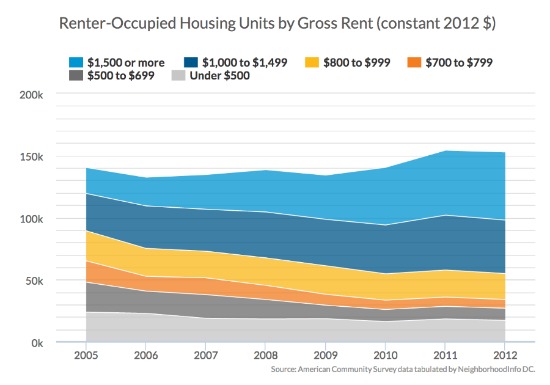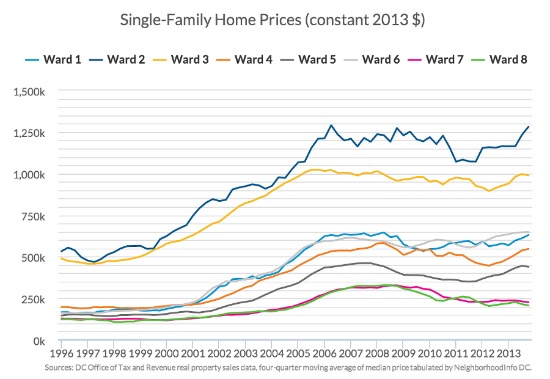 Urban Institute: Millennials Driving Skyrocketing Housing Demand and Prices in DC
Urban Institute: Millennials Driving Skyrocketing Housing Demand and Prices in DC
✉️ Want to forward this article? Click here.
A new report from the Urban Institute shows that people aged 18-34, otherwise known as millennials, are largely responsible for the massive changes that occurred in the DC housing market over the last decade or so.
“This is a national phenomenon, and DC is at the sharp end of the wedge,” said Peter Tatian, the author of the housing report, which is part of the group’s Our Changing City project. “A lot of younger, generally well-educated people seeking out new jobs — that’s been the big increase in terms of population that we’ve seen in DC over the past decade and a half.”
The report compares 2011, when nearly 67 percent of people who moved to the city within the past year were aged 18 to 34, to 2005, when that number was 57 percent. Millennials make up 35 percent of DC’s population, but just 23 percent of the national population.
But they’re far from the only stakeholders in the District’s future, Tatian said.
“Millennial migration is a big factor, but one of the points we want to make is that of course they’re not the only people living here,” he said. “Also, over time, they’re going to get older and they’re going to get married, start families and buy a home, so looking ahead, the city needs to see how if makes itself a friendly place for families.”
To compile the report, Tatian gathered data from local and national sources to give DC residents and stakeholders a big-picture look at what’s happening to housing in the city, and to capture the change that Washington’s undergone over the last 15 years.
“DC was a city that was losing population, that had a lot of problems with drugs and crime and local government credibility and respectability, but in the past 15 years that’s really changed dramatically,” Tatian said. “We’re seeing Washington now as a city that’s attracting a lot of new people, attracting a lot of investment and is seen as kind of an exciting place to be and a good place to live.”
How good a place, exactly? Well, good enough that it’s getting a lot harder to find an inexpensive place to live. The housing report shows that a rising proportion of DC’s housing stock is composed of properties fetching $1,500 or more a month, while the share of studios and one-bedrooms made available to those with the lowest incomes has taken a dive.
As for how millennials are affording those Class A rents, Tatian has a couple of theories.
“The income levels of these new residents don’t seem particularly high,” he said. “People double or triple up in apartments to afford rents, maybe they’re getting help from family.”
The lowest-income earners are left the furthest behind, and DC’s lack of affordable housing is front and center in the report. The scarcity of affordable housing isn’t due to a lack of space for housing: An earlier report on demographics shows that DC is hardly one of the country’s densest cities. It’s not among the top 125 most-dense US cities, and its densest neighborhood, Foggy Bottom, has a density comparable to Brooklyn.
“We do need to build more housing and we are building more housing,” Tatian said. “Part of the issue is amount and some of it is what kind of housing we’re building. I understand the arguments about the need for loosening some of the restrictions on things like height, higher density, or relaxing height restrictions near Metro stations, but I don’t think that’s a major impediment.”
If rents continue to rise, Tatian says, DC could put itself at risk of losing some of the millennial migration that’s helped revitalize the city. During the recession, he said, DC was a sought-after place to live not just because of the stabilizing force of the federal government, but also because of its better cost and quality of living compared to, say, New York. With its cost of living rising significantly, the city is at risk of losing that draw.
One way to help fix it, as well as the housing problems experienced by lower-income, long-time residents? Build less expensive housing.
“It’s not just a question of land availability — it’s also, ‘what are developers building?’” Tatian said. “If they’re going to continue to build Class A, that’s just going to be expensive stuff. You have to have a balance.”
See other articles related to: our changing city, urban institute
This article originally published at https://dc.urbanturf.com/articles/blog/urban_institute_millennials_driving_skyrocketing_housing_demand_in_dc/9060.
Most Popular... This Week • Last 30 Days • Ever

With frigid weather hitting the region, these tips are important for homeowners to ke... read »

Today, UrbanTurf offers a brief explanation of what it means to lock in an interest r... read »

A new report from DC’s Office of Revenue Analysis highlights how millennials and wo... read »

The 30,000 square-foot home along the Potomac River sold at auction on Thursday night... read »

An application extending approval of Friendship Center, a 310-unit development along ... read »
DC Real Estate Guides
Short guides to navigating the DC-area real estate market
We've collected all our helpful guides for buying, selling and renting in and around Washington, DC in one place. Start browsing below!
First-Timer Primers
Intro guides for first-time home buyers
Unique Spaces
Awesome and unusual real estate from across the DC Metro
















